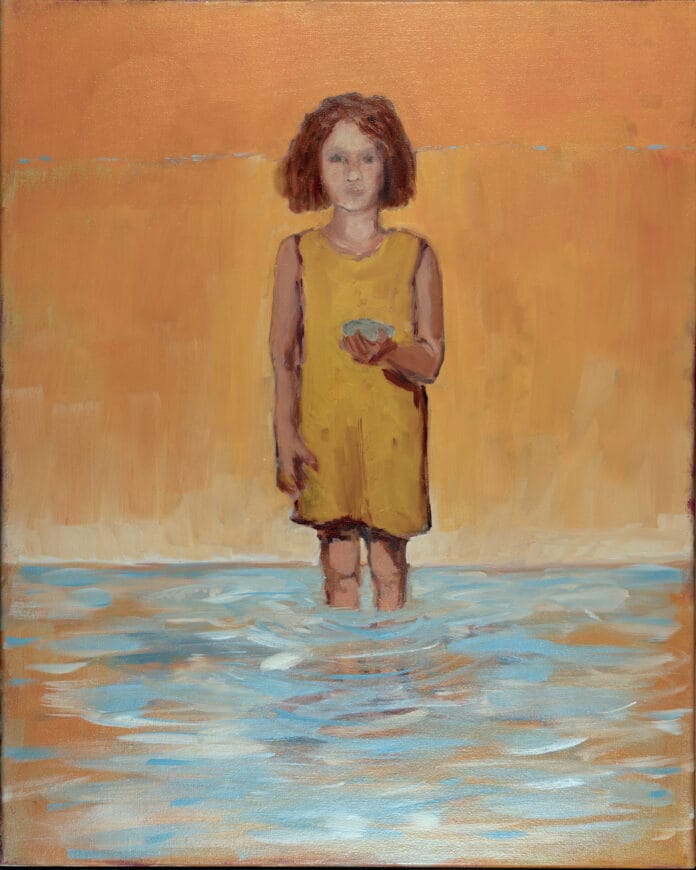Molly Mackaman is a painter based in New York’s Hudson Valley. She received her BFA in painting and drawing from the University of Iowa in the mid-1980s, laying the foundation for her lifelong commitment to art. After graduation, she moved to New York City, where she would live for more than three decades.
During that time, Mackaman balanced her creative practice with a wide variety of non-art-related roles. She worked as an administrative assistant at the United Nations, wrote press releases for a PR firm specializing in high-end design, and later taught at public schools in Brooklyn. At the same time, she raised two children and found ways to weave creativity into her daily life. As a teacher, she delighted in sneaking art projects into the curriculum, giving students a chance to explore creativity in unexpected ways.
Even amid the responsibilities of work and family, Mackaman never let go of her art. She often painted in the early morning hours, long before the rest of the day began. This discipline kept her practice alive for years, even when time was scarce.
A Return to Painting
In 2020, Mackaman retired from teaching and finally had the freedom to fully dedicate herself to her painting practice. This shift marked a turning point, allowing her to embrace the subjects and themes that resonated most deeply with her.
Her current work focuses on the human figure, exploring its ability to reveal psychological depth and complexity. Through nuanced compositions, Mackaman engages with ideas of vulnerability, resilience, and the quiet power embedded in human presence.
The Symbolism of “Tesoro”
One of her most striking works is “Tesoro”, an oil on canvas whose title translates from Italian to “treasure.”
The painting depicts a young girl standing in shin-deep water, holding an unopened oyster shell. The oyster, with its hidden pearl, becomes a powerful metaphor for potential and possibility. Like the shell, the girl’s life is still unfolding, her future a mystery yet to be revealed.
But the scene also carries a subtle sense of unease. The water surrounding the girl is rising, suggesting both environmental instability and the broader uncertainties of life. Despite this, the child clutches the oyster shell with courage, tenderness, and determination. Her posture conveys both hesitation and resolve, embodying the tension between fragility and strength.
In “Tesoro,” Mackaman captures the paradoxes of youth: innocence paired with awareness, hope entwined with doubt. The result is a work that feels deeply contemporary, resonating with themes of resilience in a world marked by instability.
Exploring Psychological Dimensions
Mackaman’s art is not simply figurative; it is psychological portraiture. Through the gestures, postures, and expressions of her subjects, she reveals the hidden dimensions of their inner lives. Her paintings invite viewers to reflect on their own experiences of uncertainty, courage, and growth.
This is especially evident in “Tesoro,” but it runs throughout her body of work. By situating figures in moments of emotional tension, she opens up a dialogue between viewer and subject, one that asks us to look inward as much as outward.
Experience as Inspiration
Mackaman’s paintings carry the weight of her lived experience. Her years of balancing art with professional life, parenting, and teaching shaped her sensitivity to both resilience and vulnerability. Teaching in Brooklyn public schools, for instance, gave her insight into the importance of creativity as a means of survival and expression, something she carried back into her studio practice.
Even her time in seemingly unrelated fields like working at the United Nations or writing for a design-focused PR firm offered her unique perspectives on human stories and the ways they can be communicated. These experiences enrich her art, adding layers of depth and meaning.
Conclusion
Molly Mackaman’s story is one of perseverance and renewal. After decades of carving out time to paint in the margins of her life, she has embraced her identity as a full-time artist. Her work, especially “Tesoro,” embodies the courage, tenacity, and tenderness required to hold onto what is most valuable even as the waters rise.
Through her exploration of the human figure and the psychological dimensions it contains, Mackaman invites viewers to reflect on their own treasures, their own challenges, and the hope that persists despite uncertainty.


